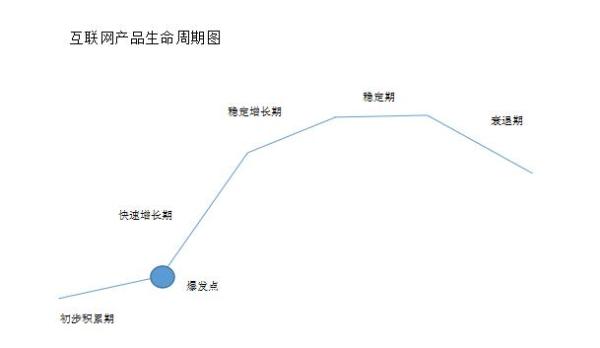From accumulation to decline, the general law of product life cycle

This diagram is an Internet product life cycle diagram that I summarized a few years ago. It is a general rule that can be used to guide product operations.
However, I mainly use it for product planning.
In this picture, there is a very critical point, which is the turning point between the initial accumulation period and the rapid growth period - the explosive point.
The vast majority of Internet entrepreneurial projects and companies die before the flash point. In the rapid growth period, stable growth period and stable period, few companies die (that is, many companies are acquired). In other words, only if you can survive to the breaking point, you are alive.
First, we define five indicators.
Target User: This product can meet this user's needs. How big the market demand is, how big the target user group is.
Valid user: This user has used this product to meet their own needs. Those who only use this product for experience or other purposes and not to meet their own needs are not considered effective users.
Active users: Valid users who have recently used this product.
Core users: This product is the first and main choice when there are relevant needs. Core users often actively participate in the operation of the product to a certain extent (for example, content contribution, product dissemination, organizational participation in online and offline activities, etc.)
Seed User: A typical user of this product who is influential. Core users can be regarded as seed users. Some of the more influential users among the effective users can also be regarded as seed users.
The growth in the number of seed users and core users can stimulate the growth of effective users and active users to a great extent. This is also the reason why many Internet products always operate around seed users and core users.
Here, we use active users as an indicator to look at this graph, because the number of active users basically represents the success or failure of a product.
There is a premise that this product meets the basic needs of target users.
The first stage is the initial accumulation period. At this stage, the product initially enters the market. It is a process in which the product continuously adjusts and adapts to user needs and experience, and finally forms a more mature product.
The principle of product planning at this stage is to get through this stage quickly and reach the breaking point as quickly as possible. Therefore, at this time, product planning must always consider what products and what functions can quickly acquire seed users and core users (the acquisition of core users has a transformation process, that is, how to quickly convert effective users into core users). Because the number of seed users and core users determines the growth rate of effective users and active users.
The second stage is the rapid growth stage. In this stage, the number of active users and effective users will grow rapidly, and the core users will also grow rapidly.
At this stage, the principle of product planning is how to extend this stage. Therefore, at this time, we need to consider more about what products, functions, services or experiences can convert more effective users into core users more quickly, and what products, functions, services or experiences can increase user stickiness, daily and monthly active users, etc. .
The third stage is a period of stable growth. In this stage, the growth of active users and effective users has slowed down significantly, but it still maintains stable growth. It is worth noting that at this stage, the growth rate of core users may be slower than the growth rate of active users and effective users, but it can also be faster.
At this stage, there are three principles for product planning:
The first is to improve and strengthen profitability. This is the most important thing at this stage.
The second is to improve the conversion rate of effective users to core users. The main purpose of achieving this conversion rate at this stage is to make profits.
The third is to improve the service and experience of original products in order to re-enter a period of rapid growth.
The fourth stage is the stable period. At this stage, the growth of active users has almost stagnated, and the growth of effective users has also been very slow. There are many reasons for this situation, including competition factors and the reason that target users have basically been covered. There are also reasons why the product model itself no longer adapts to the market, etc. But it is still possible for core users to maintain a certain growth, which is mainly caused by the inertia of users. Of course, this inertia will disappear quickly or slowly. The growth of core users often means an increase in profitability.
Therefore, there are three principles for product planning at this stage:
The first is to improve the conversion rate of effective users to core users.
The second is to improve and strengthen profitability.
Third, and the most important thing at this stage, is to improve the service and experience of the original product in order to re-enter the rapid growth period, or to find and test new products that can re-enter the rapid growth period based on existing users and resources. This determines whether this product or team can continue to survive in the future.
In fact, at this stage, it is more important to look for new products that can enter a period of rapid growth again based on existing users and resources. Because it entered a stable period, it largely shows that the efforts to improve the service and experience of the original products in the stable growth period in order to re-enter the rapid growth period have failed. Therefore, at this time, it is necessary to consider new products or make disruptive innovations to original products and change the model of original products.
The last stage is the decline stage. In this stage, active users and core users are in a state of overall loss, and the loss is often accelerated.
Therefore, the product planning principle at this stage is to find ways to enter a period of rapid growth again, whether it is to make new products based on existing users and resources or to improve original products.
If this product is going to be abandoned, then in principle, this period should be used to maximize benefits.
The above is purely based on experience and may not be suitable for all situations and products. In fact, there are many different planning principles for Internet products. I just summarized one.

关注我的微信公众号

